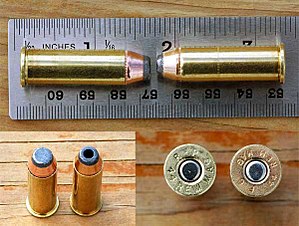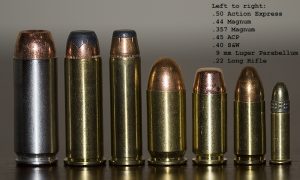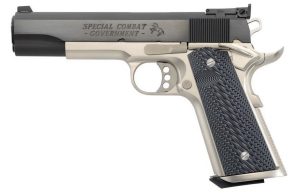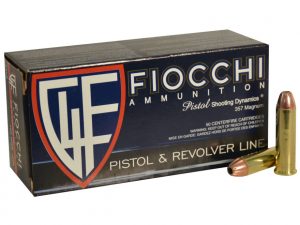The .44 Magnum has been called “the most powerful gun on earth” and, at one time, that was true. While other guns have stolen the title from the iconic round, the .44 Mag remains a favorite with handgun hunters and those looking for a solid self-defense ammunition. It hits its target hard and fast, leaving a deep channel in its wake. The .44 Magnum intimidates novice shooters with good reason, its strong muzzle flash and heavy recoil are hard to handle without ample practice.
History
Elmer Keith designed the .44 Remington Magnum in 1955. Keith, an Idaho rancher, writer and firearms enthusiast, had made a name for himself when he created the .357 cartridge. Keith’s goal was to make an all-purpose round to be manufactured by the Remington Arms Co. Remington produced the cartridge but it was slated to be used in the Smith & Wesson Model 29. As such, S&W is usually credited with introducing.44 Mag ammo to the public. However, Ruger introduced its ammo first, attached to their new single-action .44 Magnum Blackhawk.
Unlike John Browning and other designers, Keith’s aim was to create a round that was practical for multiple uses. The premise paid off, making Keith’s ammunition popular with a wider audience.
Development
Keith spent years making custom loads for the .44 Special before he created the .44 Magnum. He based the new ammunition the .44 caliber bullet but used a high-pressure load to ensure that the new ammo could fire a heavy bullet. The bullet made the ammo faster and stronger than anything the public had seen.
Design
Keith had originally intended for the .44 to be used for self-defense, hunting, and target shooting. The round is strong and packs a hefty punch. The .44 is precise, giving the shooter as much as a 90% accuracy rate. However, the high-pressure causes it to have a heavy recoil and muzzle flash, making it less than ideal for novice shooters. Those that find the .44 Mag a bit too intense may opt for the .44 Special, a slightly smaller cartridge with less recoil.
Specs
Remington created the .44 Mag as ammo for a revolver, however, it can also be used in other guns including lever action rifles, carbines, and semi-automatic pistols.
The .44 Magnum cartridge uses a bullet with 240 grain (gr), has a velocity of 1,350 feet per second (fps), and puts off a muzzle energy of 971 foots pounds (ft-lbs). The .429-inch lead bullet sits in a straight-walled case that measures 1.285 inches long. The total length of the ammo is 1.61 inches. It uses a large pistol primer. It can be loaded to a max pressure of 36,000 pounds per square inch (psi).
.44 Special
Some shooters revert to the .44 S&W Special, a smaller round with has less recoil. Experts say shooters should test both types of ammo to choose the one with the most comfort. The .44 Mag has high pressure, so it can only be used in guns chambered for the round.
Popularity
The .44 Magnum wasn’t selling well in the marketplace until 1971 when Clint Eastwood made his debut as “Dirty” Harry Callahan. Dirty Harry was the lead character in the movie, a hard-boiled San Francisco police detective who routinely faced off with criminals that plagued his city. Dirty Harry stands toe to toe with a wounded bank robber when he delivers his famous speech:
“I know what you’re thinking: ‘Did he fire six shots or only five?’ Well, to tell you the truth, in all this excitement, I’ve kinda lost track myself. But being this is a .44 Magnum, the most powerful handgun in the world, and would blow your head clean off, you’ve got to ask yourself one question: ‘Do I feel lucky?’ Well, do you, punk?”
After the movie hit the theaters, Eastwood’s devotion to his S&W Model 29 and .44 Mag skyrocketed sales and kept the Model 29 and its ammo at the top for decades. It’s hard to tell how many thousands have practiced that very line in front of the mirror.
The .44 Mag is no longer the most powerful handgun in the world, but its popularity will live on forever.
Self-Defense
Seasoned shooters often disagree regarding the .44 Magnum as a top choice for self-defense purposes. Experts claim that the .44 Mag is too powerful because of the round’s deep penetration. Inexperienced users can easily cause collateral damage through over penetration or run the risk of shooting innocent parties.
Shooters should know that .44 Magnums aren’t all the same. Some guns can be used for home defense while other, less powerful weapons are better suited for sports and target shooting.
Best .44 Mag Self-Defense Ammo
Buffalo Bore: Anti-Personnel 180 Grain Lead Hollow Point
This round is touted as one of the best for self-defense. It is a no nonsense ammunition designed for self-defense and eliminating two-legged targets. It has a Muzzle Velocity of 1500 fps and a Muzzle Energy of 899 ft-lbs.
Buffalo Bore: Anti-Personnel 200 Grain .44 Spl Wadcutter
According to Buffalo Bore: “This load is designed to permanently and quickly disable human threats.” This powerful round offers a Muzzle Velocity of 1300 fps and a Muzzle Energy of 751 ft-lbs.
Federal Ammunition: 240 Grain Fusion
This medium-priced American-made Fusion bullet with brass casing delivers 887 ft-lbs Muzzle Energy.
Federal Ammunition: Hydra-Shok 240 grain Personal Defense
The new production Hydra-Shok 240 grain Personal Defense round is an excellent choice for concealed carry and law enforcement agencies. The center-post design delivers controlled expansion. The notched jacket gives maximum penetration. It offers a Muzzle Velocity of 1180 fps and Muzzle Energy of 742 ft-lbs.
Fiocchi Ammunition: 240 Grain JSP
Coming in at the same price as the Remington, this foreign made 240 grain self-defense round offers 1838 FPS velocity.
Hornady Ammunition: JHP XTP Load
Hornady XTP is highly recommended by seasoned shooters. The American-made self-defense cartridge makes the list for the best .44 self-defense ammo. It’s slightly more expensive than the Remington, but also more powerful. It boasts 1150 FPS Muzzle Velocity.
Remington Ammunition: 240 Grain HTP Rounds
Top of the list of the best .44 ammo for self-defense. Available in 240 grain SP and SJHP rounds, this American-made defense load is inexpensive, but powerful. It boasts 1180 FPS Muzzle Velocity and 742 ft-lbs Muzzle Energy.
Speer: Gold Dot Handgun Personal Protection 44 S&W Special
Speer Gold Dot has an excellent reputation for quality and accuracy. This 200 grain hollow point has plenty of what it takes for self-defense. It offers 875 fps of Muzzle Velocity.
Winchester Ammunition: Platinum Tip 250 Grain JHP
A bit more expensive than the other brands, Winchester offers this American-made self-defense cartridge with 1250 FPS Muzzle Velocity.
Conclusion
The .44 Magnum is a powerful gun that is not well suited to concealed carry. It is an excellent choice for self-defense although some claim that the .357 Magnum is easier to carry and aim. In the end, personal comfort and performance wins the day, leaving the choice to the shooter.




